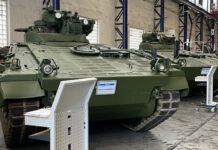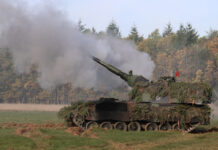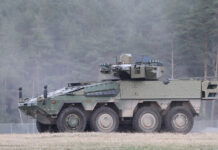The Bundeswehr special fund was legally established in July 2022. In the initial economic plan, a total of 38 projects were listed in five spheres, totalling EUR 100 billion. In December 2022, a new economic plan – heavily revised following criticism – was adopted for the first time in connection with the adoption of the federal budget for financial year 2023.
The Bundeswehr special fund provides EUR 100 billion for the “financing of significant Bundeswehr equipment projects, in particular complex multi-year measures”. In the first edition of their economic plan, the Federal Ministry of Defence packed the entire budget with projects without taking into account the interest to be borne by the special fund. Following criticism from the Federal Audit Office, this was taken into account when drawing up the economic plan for the 2023 budget. This reduced the available amount to EUR 92 billion and later – taking into account rising interest rates – to EUR 87 billion. As a result, numerous projects had to be removed from the economic plan. The interest burden may increase further due to the long timespans of some projects.
In December 2022, the German Bundestag’s Budget Committee approved the first projects for the special fund with proposals valued at EUR 25 million, including the procurement of 35 F-35 Lightning fighter aircraft, the most expensive to date (EUR 8.3 billion) and one of the longest projects with a term until 2031. The Ministry of Defence had announced over 70 EUR 25-million proposals for 2023, some of which were for projects from the special fund. The table below lists the majority of the projects that have already been approved. At the time of writing, there remain a double-digit number of proposals left to be presented at the meetings of the Budget Committee still to take place by the end of 2023.
| Approved special fund proposals | ||
| Project name | Value (EUR millions) | Project end date |
| Handheld and vehicle radios | 33 | 2024 |
| Airborne rescue centres | 40 | 2024 |
| Interchangeable loader systems and platforms | 317 | 2025 |
| Eurofighter, development of e-scan radar | 84 | 2025 |
| Command and control equipment IdZ | 51 | 2026 |
| Air defence system IRIS-T SLM | 950 | 2027 |
| Reconnaissance and anti-submarine warfare system Poseidon | 2,803 | 2027 |
| Simulator for P-8A Poseidon | 180 | 2027 |
| Support services D-LBO | 57 | 2028 |
| Puma infantry fighting vehicle, 2nd batch | 1,500 | 2028 |
| Crypto modernization TP 2b | 70 | 2028 |
| Puma infantry fighting vehicle, retrofit 1st lot | 851 | 2029 |
| CATV over-snow vehicle | 1,471 | 2030 |
| Caracal airborne platform | 1,398 | 2030 |
| Arrow missile defence system | 4,005 | 2030 |
| F-35 Lightning II fighter aircraft | 8,300 | 2031 |
| Heavy transport helicopter STH | 7,216 | 2032 |
| Total (EUR) | 29,362 | N/A |
Planning status
Only a few of the projects in the special fund – such as the F-35 or the heavy transport helicopter (STH; Schwerer Transporthubschrauber) – are genuinely new projects. The majority are transfers from the core budget of Section 14. The armaments investment part of the budget has been decreasing continuously since 2022. While it was still EUR 12.2 billion in 2022, the figure for 2023 fell to EUR 9.6 billion. The draft for 2024 envisages a further reduction to EUR 3.9 billion. The special fund is therefore increasingly mutating into the financing of ‘normal’ projects. The intended effect as a booster for the modernisation of the Bundeswehr is visibly evaporating.

Credit: Lockheed Martin
At the Bundeswehr conference in November, Federal Chancellor Olaf Scholz described it as a good sign that “more than half and probably two thirds of the special fund will already be contractually committed by the end of the year.”
However, the conclusion of contracts and the contractual commitment of budget funds do not lead to an immediate outflow of funds, nor an immediate inflow of equipment. It can take several years for the first weapon systems to be delivered, particularly in the case of large-scale projects. Expenditure of EUR 8.4 billion from the special fund is planned for 2023, although at the time of writing it is unclear how much of this has actually been spent. In recent years, it has been repeatedly shown that investment funds for armaments have not been fully used despite dwindling resources.
The special fund is playing an increasingly important role in achieving NATO’s goal of spending 2% of gross domestic product (GDP) on defence. The Establishment Act states that this target is to be achieved with the help of the special fund over a multi-year average with a maximum of five years. In view of the stagnating defence budget of EUR 51 billion, the special fund must take on an ever-increasing share.
This is achieved by transferring numerous projects to the special fund that, according to the law, do not belong there. For example, expenditure of EUR 19.2 billion is planned for 2024. In subsequent years, the financial injection required from the special fund to achieve the 2% target will increase because GDP is set to rise again, but the defence budget will not. It is therefore foreseeable that the special fund will soon be exhausted. Insiders expect that no more funds will be available from 2026. Almost all of the projects listed in the table will not have been completed by then, and some of them will be in the planned peak of their spending phase.

Credit: Rheinmetall
The future
There are two basic options to ensure that the projects continue to be financed and that the 2% target is achieved: Firstly, the Bundeswehr special fund could be increased. This would again require overarching cooperation, in which not only the governing coalition but also the opposition would have to agree on a joint approach. The other option is to increase the defence budget by EUR 20–30 billion from 2026 at the latest. This increase could be prepared for now by adjusting medium-term financial planning.
Currently, a political solution seems extremely difficult with regard to either option. In addition to the security crisis arising from conflicts in Ukraine and Israel, both the climate and economic crises pose further challenges for financial planners. Additionally, their financial plans have recently been shaken by the Federal Constitutional Court, which has torn a EUR 60 billion hole in the German budget with its ruling that the Scholz Government’s Second Supplementary Budget Act was unconstitutional.
Federal Defence Minister Boris Pistorius has demanded that the Bundeswehr must become fit for war. In addition to a change in the mentality of German society, and well-trained, motivated personnel, the third pillar of readiness for war is modern equipment for the armed forces. The Bundeswehr special fund was intended to accelerate the modernisation of equipment, and this appears to be succeeding, albeit partially. However, the increasing dilution of the special fund and the lack of support due to the collapse of the defence budget are putting modernisation on the back burner. The Bundeswehr’s equipment must be financed with a long-term perspective. This is the only way to ensure planning security for the troops and their commanders, but also for the defence industry responsible for modernising the Bundeswehr’s equipment.
Gerhard Heiming











